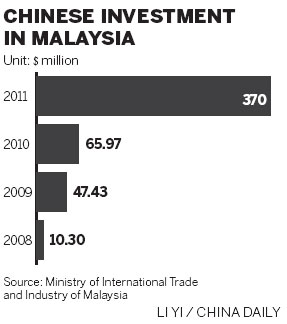Chinese investors flocking to Malaysia
17 january 2013
Exploring business opportunities in Southeast Asian country offers a route into more ASEAN markets, as Bao Chang reports in Malacca.
|
 |
|
Performers from Johor State, Malaysia, dance at the eighth China-ASEAN Expo in October 2011 in Nanning, the Guangxi Zhuang autonomous region. [Photo/Xinhua] |

Across the blue Strait of Malacca, there will be a man-made island, that is poised to become a new travel hub of Malaysia, and is set to appear in 2020.
Northwest China’s Gansu Chamber of Commerce, along with Malaysia’s Mestika and IEPU, have invested 1.3 billion yuan ($206 million) to establish the island as a new landmark in Malacca that engages in the travel, entertainment, commerce, culture and resort businesses, most of which will involve Chinese investors.
“Walking through Malacca, the legendary ancient city, I feel little exotic atmosphere, because the major business street is full of shops and hotels with a glittering array of Chinese billboards,” said Song Liuming, a Chinese tourist.
Linking the Pacific and Indian oceans and located at the crossroads of Asia and Oceania, the Strait of Malacca has been a trading passage since the days of Zheng He, China’s most famous navigator, who visited it five times during the Ming Dynasty (1368-1644).
Today, Chinese people are enthusiastic about investing this ancient city, which has many historical connections to China.
According to the market researcher MYC MM2H SDN BHD, most of the investment in the 607-hectare island is from Chinese investors.
In this traditional economic hub of Malaysia, the most active businessmen are undoubtedly Chinese. Chinese companies are also the country’s biggest trading partner.
Song, an entrepreneur from Jiangsu province, said that he saw business opportunities in the travel industry and was sure it would be very profitable to invest and set up a tourist agency in the country.
“There are a lot of beautiful resorts in Malaysia that are attracting more and more Chinese tourists. But the travel service is still not as developed as that in the Chinese market,” Song said.
China has become Malaysia’s third-largest source of tourists, following Indonesia and Singapore. In the first half of the year, 758,300 Chinese tourists visited Malaysia, up 34 percent year-on-year, according to the Malaysia Tourism Bureau.

Li Liping, general manager of Zhejiang Tonghui Investment Company, said he plans to invest in Malaysia’s catering industry.
“Our company has set up a comprehensive network in China’s catering industry and our next plan is to go abroad,” said Li.
Li revealed that Malaysia will be the company’s first overseas investment destination, where it will open a Chinese restaurant, to take advantage of the two countries’ linguistic and cultural similarities.
Active investors
Ong Chong Yi, minister counselor for economic affairs at the Malaysian embassy in China, told China Daily that over the past three years, Chinese investors have been active in the construction sector in Malaysia but have less presence in the service sector.
The liberalization of the country’s service sector gives Chinese companies opportunities to explore new areas of business, Ong said.
“We concentrate on attracting high technology, knowledge and capital-intensive investment tailored to economic growth and development,” he said.

Recent Comments